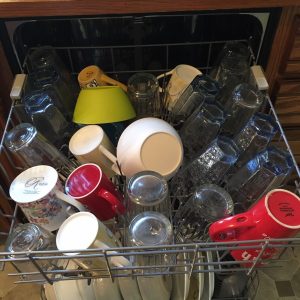Expanded title: Practical and Relational Tips for Doing Dishes. Let me begin by saying that I do not fault any one, especially those without a dishwasher, for using some disposable plates and cups. Desperate times like these call for finding the best and simplest way to clean up after our meals at home. Now, I’d like to address the most important aspect – practical or relational – of cleaning up the kitchen.
I have to go with relational and hope readers don’t skip down to my practical tips. I found an article on The Atlantic’s website last fall entitled, Doing Dishes is the Worst. Author Caroline Kitchener (her real name?) cited research from the Council of Contemporary Families, a nonprofit that studies family dynamics, as she sought to answer the question: At the end of the day, who is going to do the dishes? The CCF puts forth that the answer can have a big impact on the health and longevity of a relationship. Women who wash most of the dishes reported more conflict, less satisfaction, and even worse sex that women with partners who help. They would like help with this task more than any other.
 Bacon grease is the worst! I bought Dave a bacon shirt for Christmas.
Bacon grease is the worst! I bought Dave a bacon shirt for Christmas.
Now to the women who are saying AMEN, let’s think about this. Are we willing to have someone, whether it be a spouse, roommate, or child, help with a chore that we can do better and faster ourselves? Considering the payoffs, I would say yes. Whether you wash and dry by hand or use a dishwasher, the task can be divided up, accomplished by a team, and that’s a healthy family dynamic.
Suppose the other dish dirtier has not been helping. Could it be that they feel embarrassed about not knowing how you would like the work done and don’t want to risk being belittled? Isn’t it crazy how such mundane parts of daily life can cause frustration and conflict? I shared some thoughts relevant to this question in A Happier New Year.
So, if you’re the person who has not been helping in the kitchen and you are willing but unsure how to approach the expert, swallow your pride and ask for some instruction. And, if you’re the one who has been working alone, wishing someone, anyone, would help you, resist the temptation to criticize or point out that “It’s about time.” Take a minute and think about which is more important, having things done your way or encouraging the person you love and live with.
Whew! That’s over. Now to some practical tips for using a dishwasher.

This is my top rack, full and ready to run. I load the cups where they angle the most because I don’t like getting a wet hand when I unload. I’m careful not to put small plastics near openings they could slip through (we learn from experience!). Keep in mind that the lettering on your favorite mug might wear off with repeated washing and that plastic items from decades ago might not be dishwasher safe.

Here’s my bottom rack, ready for washing. No plastics here! Those three pieces in the middle are not ideally placed, but I like to keep hand washing (dishes) to a minimum. We use the slots for silverware so we don’t end up with spooning spoons. Knife blades go down, forks and spoons go handles down. Sharp knives are hand washed. It’s safer and keeps the blades from dulling.
We hand wash pans, large bowls, and most of our cutting boards. They get cleaner and we have more room for smaller pieces.
When it’s time to unload, I pull out the bottom rack first. That keeps any water left on the top dishes from dripping on the clean bottom dishes.
Remember to be grateful for the food we have, the dishes we eat from, the access to hot water, and especially the people in our households.
